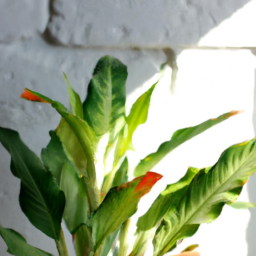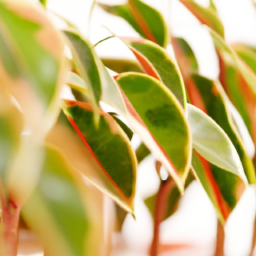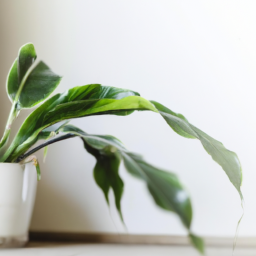
Are you looking to bring some life and greenery into your home? Indoor window plants are a great way to add a touch of nature to your living space while also improving air quality and boosting your mood. Whether you have a green thumb or are just starting out with houseplants, there are plenty of options to choose from that will thrive in the sunlight streaming through your windows. In this blog post, we’ll explore the benefits of indoor window plants, as well as provide tips on how to care for and display them in your home. So grab a cup of tea, sit back, and let’s dive into the wonderful world of indoor window plants.
Benefits of Growing Indoor Window Plants
Improved Air Quality
One of the most significant benefits of growing indoor window plants is the improvement in air quality. Plants have the ability to absorb carbon dioxide and release oxygen through the process of photosynthesis. This can help to reduce the levels of harmful toxins in the air, such as formaldehyde and benzene, which are commonly found in indoor environments. In addition, plants can also help to increase humidity levels, which can be beneficial for those who suffer from dry skin or respiratory issues.
By placing plants near windows, where they can receive ample sunlight, you can maximize their air-purifying benefits. Some of the best plants for improving air quality include spider plants, peace lilies, and pothos. These plants are not only beautiful additions to your home decor, but they also serve a practical purpose in keeping the air clean and fresh.
Overall, growing indoor window plants can help create a healthier living environment for you and your family, allowing you to breathe easier and feel more refreshed.
Stress Reduction
Another benefit of growing indoor window plants is their ability to reduce stress and promote a sense of well-being. Studies have shown that being around plants can help to lower blood pressure, reduce anxiety, and improve overall mood. The presence of greenery indoors can create a calming and peaceful atmosphere, making your home feel like a sanctuary away from the stresses of daily life.
Placing plants near windows allows them to receive natural sunlight, which can further enhance their stress-relieving properties. Sunlight is known to boost serotonin levels in the brain, which can help to improve mood and promote feelings of happiness and relaxation. By creating a sunny spot for your indoor window plants, you can create a tranquil oasis where you can unwind and recharge.
Whether you choose to grow flowering plants, succulents, or herbs, having a variety of plants near your windows can help to create a soothing and rejuvenating environment that promotes mental and emotional well-being.
Enhanced Aesthetic Appeal
In addition to their health benefits, indoor window plants can also enhance the aesthetic appeal of your home. Plants add a touch of nature and color to any space, creating a vibrant and inviting atmosphere. By placing plants near windows, where they can receive ample sunlight, you can showcase their beauty and create a stunning focal point in any room.
There are endless possibilities when it comes to choosing indoor window plants, from cascading vines to bold tropical foliage to delicate flowering blooms. You can mix and match different plant varieties to create a visually appealing display that reflects your personal style and taste. Whether you prefer a minimalist look with a few statement plants or a lush jungle vibe with a variety of greenery, indoor window plants can help you achieve the aesthetic you desire.
By incorporating plants into your home decor, you can bring the beauty of the outdoors inside and create a welcoming and harmonious living space that you can enjoy year-round.

Best Types of Indoor Window Plants for Beginners
Choosing the Right Plants
When it comes to choosing the best types of indoor window plants for beginners, there are a few key factors to consider. First and foremost, you’ll want to think about the amount of natural light that your windows receive. Different plants have different light requirements, so it’s important to match the plants to the light levels in your home.
Some great options for low-light environments include snake plants, pothos, and peace lilies. These plants are low-maintenance and can thrive in areas with minimal sunlight. If you have windows that receive direct sunlight for a good portion of the day, you may want to consider plants like succulents, cacti, or spider plants. These plants love lots of sunshine and will thrive in bright, sunny windows.
Another important factor to consider when choosing indoor window plants is the size of the plants. If you have limited space on your windowsills, you may want to opt for smaller plants like air plants or small ferns. On the other hand, if you have larger windows or plant stands, you can consider larger plants like fiddle leaf figs or rubber plants.
Caring for Your Plants
Once you’ve chosen the right plants for your indoor window garden, it’s important to know how to care for them properly. One of the most important aspects of plant care is watering. Overwatering is a common mistake that many beginners make, so it’s important to water your plants only when the top inch of soil is dry.
In addition to watering, you’ll also want to make sure that your plants are getting enough nutrients. You can fertilize your plants every few weeks during the growing season to help them thrive. It’s also important to regularly dust off the leaves of your plants to ensure that they can photosynthesize properly.
Another key aspect of plant care is ensuring that your plants are getting enough sunlight. Make sure to rotate your plants every so often to ensure that all sides of the plant are getting adequate light. If you notice that your plants are leaning towards the window, it may be a sign that they need more sunlight.
Troubleshooting Common Issues
Even with the best care, indoor window plants can sometimes run into issues. One common problem that many beginners face is yellowing leaves. This can be a sign of overwatering, underwatering, or even a lack of sunlight. If you notice yellowing leaves on your plants, try adjusting your watering schedule or moving your plants to a sunnier spot.
Another common issue that indoor window plants face is pests. If you notice small bugs on your plants or sticky residue on the leaves, you may have a pest problem. You can try wiping down your plants with a mixture of water and mild soap to get rid of pests, or you can use neem oil as a natural insecticide.
By choosing the right plants, properly caring for them, and troubleshooting common issues, you can create a beautiful indoor window garden that will thrive for years to come. Happy planting!

Tips for Caring for Indoor Window Plants
Choosing the Right Plants
When it comes to caring for indoor window plants, the first step is choosing the right plants for your space. Consider the amount of natural light that your windows receive throughout the day. Some plants thrive in bright, direct sunlight, while others prefer indirect light.
It’s also important to consider the size of your windowsill and the amount of space you have available for your plants. Some plants, such as succulents and cacti, are well-suited for small spaces, while others, like spider plants and pothos, can trail and hang down from shelves or plant stands.
When selecting plants for your indoor window garden, consider the level of maintenance that each plant requires. Some plants are more forgiving and can thrive with minimal care, while others may need more attention and specific care instructions.
Proper Watering Techniques
One of the most important aspects of caring for indoor window plants is proper watering techniques. Overwatering is a common mistake that can lead to root rot and other issues, so it’s important to water your plants only when they need it.
Before watering your plants, check the soil moisture by sticking your finger into the soil. If the soil feels dry to the touch, it’s time to water your plants. Be sure to water thoroughly, allowing the water to drain out of the bottom of the pot to prevent waterlogged soil.
It’s also important to use room temperature water when watering your plants, as cold water can shock the roots. Avoid watering your plants on a strict schedule, as the frequency of watering will vary depending on factors such as the plant species, the size of the pot, and the amount of light and humidity in your space.
Pruning and Maintenance
In addition to proper watering techniques, regular pruning and maintenance are essential for keeping your indoor window plants healthy and thriving. Pruning helps to promote new growth, remove dead or damaged leaves, and maintain the shape and size of your plants.
When pruning your plants, use clean, sharp scissors or pruning shears to make clean cuts. Remove any yellowing or brown leaves, as well as any stems that are leggy or overgrown. You can also pinch off the tips of your plants to encourage bushier growth.
In addition to pruning, it’s important to regularly inspect your plants for pests and diseases. Common indoor plant pests include spider mites, aphids, and mealybugs, which can be treated with insecticidal soap or neem oil. If you notice any signs of disease, such as mold or mildew, remove the affected leaves and treat the plant with a fungicide.
Overall, caring for indoor window plants requires a combination of proper plant selection, watering techniques, and maintenance practices. By following these tips, you can create a thriving indoor garden that brings beauty and greenery into your home.
Let’s wrap up what we learned
If you’re looking to bring some life and greenery into your home, indoor window plants are the perfect solution. Not only do they add a touch of nature to your space, but they also have numerous benefits for your health and well-being. Indoor plants can help improve air quality by filtering out toxins and releasing oxygen, creating a healthier environment for you to live in. They can also boost your mood and reduce stress levels, making your home a more peaceful and relaxing place to be.
When choosing indoor window plants, it’s important to consider factors such as the amount of sunlight your windows receive, the size of the plants, and your own personal preferences. Some popular options for indoor window plants include succulents, spider plants, and pothos, all of which are relatively low-maintenance and can thrive in a variety of conditions. With a little bit of care and attention, indoor window plants can brighten up your space and bring a little piece of the outdoors inside.
Here are this week’s Top Questions and Answers
Q1. What are some easy-to-care-for indoor window plants?
A1. Some easy-to-care-for indoor window plants include pothos, spider plants, snake plants, and peace lilies. These plants thrive in indirect sunlight and require minimal maintenance.
Q2. How often should I water my indoor window plants?
A2. The frequency of watering indoor window plants varies depending on the type of plant and the environment. As a general rule, it’s best to water when the top inch of soil feels dry to the touch. Overwatering can lead to root rot, so it’s important to let the soil dry out between waterings.
Q3. What are the benefits of having indoor window plants?
A3. Indoor window plants not only add beauty and greenery to your space but also have numerous health benefits. They can improve air quality, reduce stress, boost mood, and even increase productivity.
Q4. Can indoor window plants thrive in low-light conditions?
A4. While most indoor window plants prefer bright, indirect sunlight, there are some varieties that can thrive in low-light conditions. Consider plants like pothos, snake plants, and ZZ plants, which can still grow and thrive with minimal natural light.
Q5. How can I prevent pests from infesting my indoor window plants?
A5. To prevent pests from infesting your indoor window plants, regularly inspect the leaves and stems for any signs of pests. You can also wipe down the leaves with a damp cloth to remove dust and discourage pests. If you do notice pests, you can try using natural remedies like neem oil or insecticidal soap to get rid of them.
Emily Bloomfield is an interior designer and horticulturist specializing in incorporating indoor plants into interior spaces. With a background in both design and plant science, Emily offers a unique perspective on creating harmonious living environments through the synergy of greenery and aesthetics. Her creative ideas and innovative solutions make her a sought-after authority in the field.


